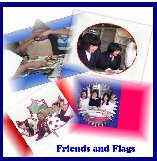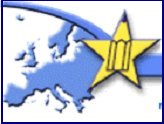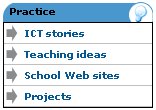Llengua anglesa a secundària. Competència digital
- guia
- Mòdul 0
- Mòdul 1
- Mòdul 2
- Mòdul 3
- Mòdul 4
- Mòdul 5
- Mòdul 6
- projecte
- índex
Projects
A telematic project consists of a number of activities that a class does collaboratively with a partner class, and which are shared over the internet. The main objective is to foster cooperative work and communication between schools. This way, the activities contribute to the students’ education and development by conveying knowledge and developing and strengthening positive attitudes, skills and values: group work, sharing responsibilities and information, learning from others, respecting opinions and cultures, just to mention a few.
There are different kinds of projects:
- According to the activity
- each school does part of the work which is sent to the partner school in order to do a joint activity.
- all the schools do the same activities and exchange results.
- According to the subjects involved
- just one school subject
- interdisciplinary
- According to the participation
- class-work
- crèdit variable
- different levels at the same time
- According to duration
- specific activities for a short period of time
- the whole school year
The projects usually include the learning activities and materials, pedagogical guidelines to help teachers implement them in the classroom, and related teaching and learning on-line resources. They also have a facilitator, that is, the person who coordinates the project, pairs the groups and makes sure that it runs smoothly. He/she is the contact person if any problems arise.
Most of the times the projects involve a final activity that shows or summarizes all the work done, such as a web page, a class magazine, a book or a poster.
In this practice we are going to have a look at some projects and the ways they can be implemented in the foreign language classroom.
Practice it!
- Global Schoolnet is an organisation which aims to provide educational opportunities that connect US students with students worldwide, so that they may communicate, collaborate and learn from one another. They have a very easy-to-use database of current projects.
One of their projects is Friends and Flags. It is a good example of a collaborative learning project which promotes multicultural awareness by connecting classrooms around the world. Participants interact with international classroom partners in a private Friends and Flags Forum, by email and by sending cultural packages to each member in their team in the post.
In the Students section they also have extra activities like quizzes, a chatroom, discussion boards, e-cards and related links to complement the classwork. As a final activity, the schools are asked to put up an exhibit or make a webpage with all the information they have collected.
- In a first stage, teachers register (for free) and receive the teachers kit by email. They are also put in contact with one or more partner school. At this point, teachers should start to communicate with each other in order to set up the details of their exchange: dates when messages are to be sent, the type of activities, if messages will be written by individual students or by the whole group.
- Once the project starts, the first activity is an introduction of the participating students. Then the rest of class activities follow. At certain times they contribute a message in a message board or in scheduled chat sessions.
By the end of the term they send a cultural package to the partner school. The main component is a country guide book which is written, illustrated, designed and produced by students in every class, but any other items that the kids want to include are acceptable.
- European Schoolnet is a similar organisation supported by the European Commission. They give the eLearning Awards every year. You may find partners there in the ComeniusSpace or participate in projects. The common thread in all of them is to make students become aware of the diversity of Europe and what it means to be a young citizen in Europe today.
One of such projects is myEurope, with a variety of short activities:
Local treasures, A symbol for the enlarged Europe, Discover Europe, Water tales, Christmas traditions.
Participation in all these projects is very easy and requires just one or two sessions. As a class, students write a short text which is then published in the project’s webpage with accompanying photos. Students learn from the others by reading their contributions.
myEurope chat is another interesting activity, in which the students debate on a topic or interview a guest online.
- Participation can be done at any time of the year. Schools must be registered in order to publish. The teachers will find more information in
Activity framework
- Methodology. Project work implies working in a different way. Although the text book is usually put aside, participating classes may learn the same contents differently. They will practise writing, reading, drawing, taking photographs, questioning, listening, observation skills and selecting good quality data. It will train pupils in many aspects of ICT, from word processing to email, or even building web pages. New possibilities and opportunities can be integrated into a model which aims to make pupils become lifelong learners and acquaint themselves with the wider world through a journey of self-discovery and interaction with others.
- Group work. Students usually work in pairs or small groups. After the teachers gives them the task, they organise their work and work autonomously. They must be aware of the deadlines and work accordingly. It is a good idea to assign a role to each member of the group: the person in charge of writing, or searching information, or communicationg… and change them from time to time so that everybody does a part of the job.
- Role of the teacher. The teacher gives the highlights of the project, explains what is to be done and how, and then supervises the student’s work and their production. He/she becomes an observer and only intervenes to give technical assistance, manage group work and occasionally, give help when language problems arise. He must also be in permanent contact with the partner teachers to ensure that the project is running correctly.
- Evaluation. At the end of the project, teachers should evaluate the project: which activities worked well and which didn’t, if there were any kind of problems (with communication, with the activities, with the students, with the computers or the software…) so that the project can be improved year after year. Students’ performance can be assessed with a rubric.
Additional info
Some bibliography on project work:
A teachers’ guide to collaborative projects
Harnessing the Power of the Web. A Tutorial for Collaborative Project-Based Learning
Proyectos colaborativos y cooperativos en internet
More international projects:
 Etwinning provides a platform for collaboration on the Internet, pedagogical and technical tools, training workshops and advice to over 12,000 schools and teachers in Europe.
Etwinning provides a platform for collaboration on the Internet, pedagogical and technical tools, training workshops and advice to over 12,000 schools and teachers in Europe.
 Partbase, the partner finding tool in order to participate in European projects (Comenius).
Partbase, the partner finding tool in order to participate in European projects (Comenius).
 IEARN International Education And Resource Network. The main objective behind all their projects is that teachers and students all across the planet work collaboratively on projects that make a difference in the world. All those projects involve a final “product” or exhibition of the learning that has taken place as part of the collaboration.
IEARN International Education And Resource Network. The main objective behind all their projects is that teachers and students all across the planet work collaboratively on projects that make a difference in the world. All those projects involve a final “product” or exhibition of the learning that has taken place as part of the collaboration.
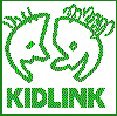 Kidlink. A number of projects with two goals in mind: learn about others to learn more about oneself and collaborate with peers across divides like distance, languages and culture.
Kidlink. A number of projects with two goals in mind: learn about others to learn more about oneself and collaborate with peers across divides like distance, languages and culture.
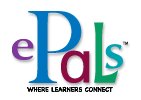 ePals.com. Keypal partners from 191 countries speaking 132 languages and cross-cultural projects. They offer free email accounts for schools.
ePals.com. Keypal partners from 191 countries speaking 132 languages and cross-cultural projects. They offer free email accounts for schools.

